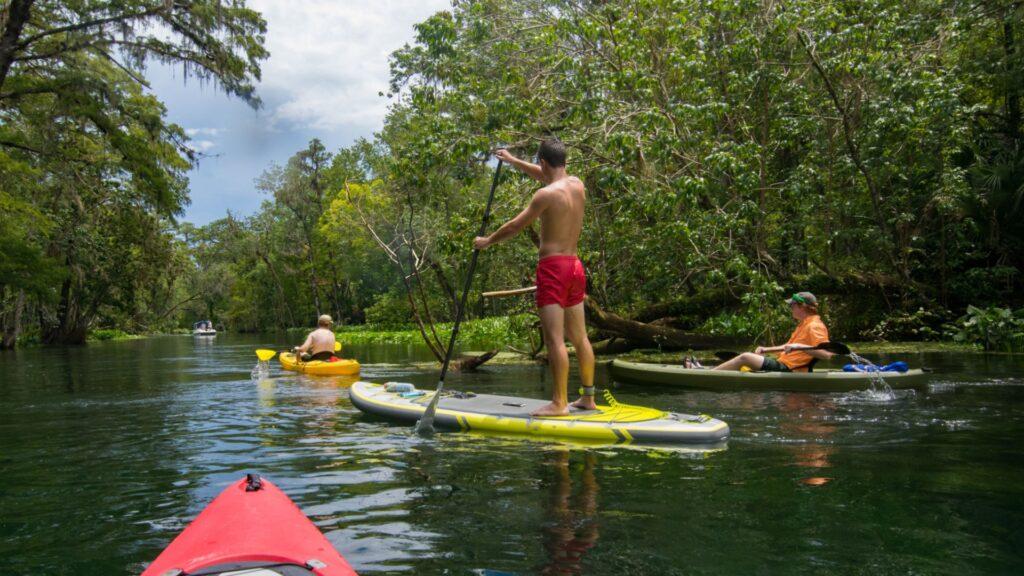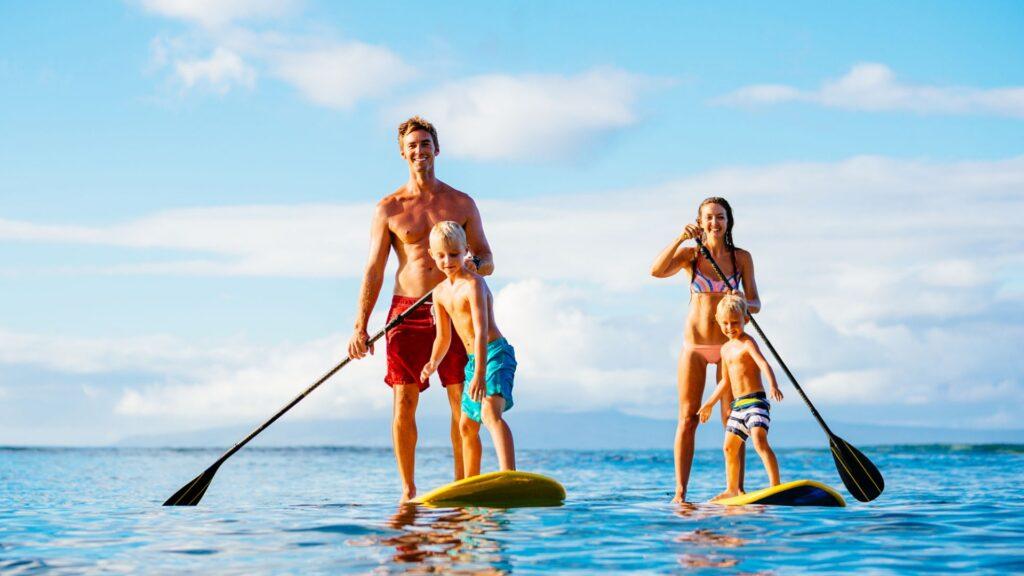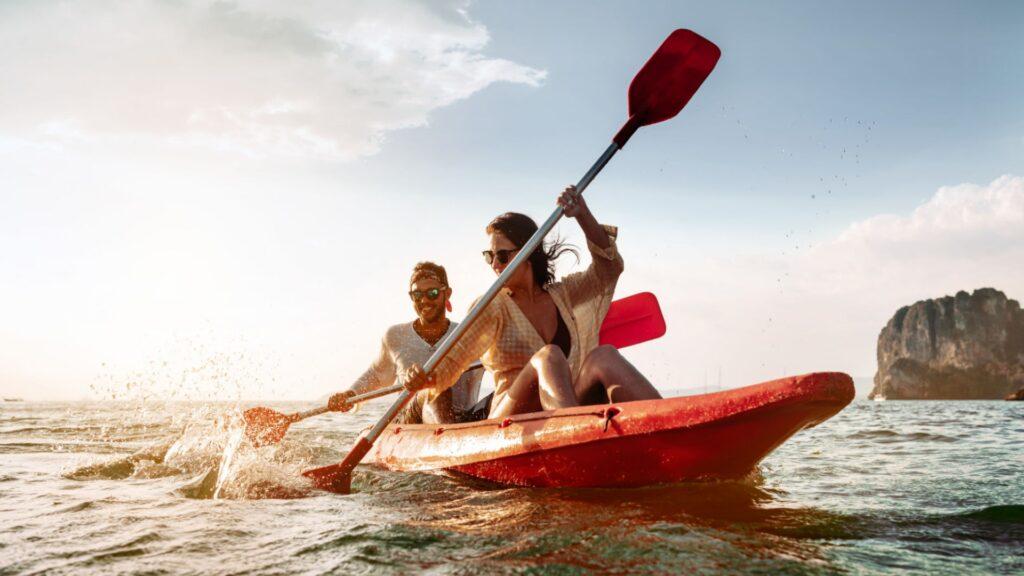Choosing between a stand up paddle board and a kayak changes your water experience. Both have special benefits for different people and skill levels.
Think about what you want before picking. Do you want a calm, peaceful ride or an exciting challenge? Do you like smooth waters or fast rapids?
We’ll look at the main differences between paddle boarding and kayaking. This will help you choose the right one for you.
Key Notes To Consider
- Understand the unique benefits of each water sport.
- Learn about the different skill levels required.
- Discover which is more suitable for your preferences.
- Explore the equipment and safety considerations.
- Find out which activity provides a better workout.
Understanding the Basics of SUPs and Kayaks
Exploring paddling sports starts with knowing about stand up paddle boards and kayaks. Both are fun and good for staying fit. But they are used in different ways and offer different experiences.
What is a Stand Up Paddle Board?
A stand up paddle board, or SUP, is a big, stable board. You stand on it and paddle with a single-bladed paddle. It’s fun to paddle through calm or whitewater.
Types of SUPs
- All-around SUPs: Great for beginners
- Touring SUPs: Good for long paddles
- Racing SUPs: Fast and for competitions
- Surf SUPs: Perfect for surfing waves
Basic Components
A SUP has a board, a paddle, a leash, and safety gear like PFDs (personal floatation devices).
What is a Kayak?
A kayak is a small, narrow boat for one or more people. You sit in it and paddle with a double-bladed paddle. It’s great for different water types.
Types of Kayaks
- Recreational kayaks: Stable and easy to use
- Touring kayaks: Good for long trips
- Inflatable kayaks: Portable and easy to carry
- Whitewater kayaks: For navigating rapids
Basic Components
A kayak has a hull, a cockpit, a rudder or skeg, and a double-bladed paddle.
Key Differences at a Glance
Stand up paddle boards and kayaks are very different. Knowing these differences helps you choose the right one for you.

Stand Up Paddle Board vs Kayak: A Direct Comparison
To make an informed decision, let’s directly compare stand up paddle boards and kayaks across several key aspects.
Design and Construction
Stand up paddle boards are made of lightweight, durable materials like fiberglass or inflatable PVC. They are designed for standing and paddling. Kayaks, on the other hand, are made from more robust materials like polyethylene or fiberglass. They are built to withstand the rigors of seated paddling.
Kayaks have a cockpit for seated paddling. Stand up paddle boards are designed for standing.
Stability and Balance
Both stand up paddle boards and kayaks offer stability, but in different ways. Kayaks are more stable for beginners because of their lower center of gravity and wider hulls. Stand up paddle boards require more balance and core strength since paddlers stand upright.
Maneuverability
Stand up paddle boards are often more maneuverable, even in calm waters. This is because they are lighter and paddlers can shift their stance. Kayaks, while maneuverable, need more effort to turn, which is harder for longer, touring kayaks.
Speed and Efficiency
Kayaks are more efficient for long distances. This is because the seated position and double-bladed paddle allow for powerful strokes. Stand up paddle boards can be fast, but staying fast over long distances is tiring due to the standing position.
Speed and Portability Comparison
- Stand up paddle boards are generally lighter and easier to transport.
- Kayaks, while often heavier, can be more efficient for long-distance paddling.
- Portability is a significant factor, with inflatable stand up paddle boards offering a high level of convenience.
Weight and Portability
Stand up paddle boards, and inflatable ones in particular, are more portable and easy to store than kayaks. Kayaks, though sometimes more cumbersome, are more efficient for longer trips. This can make up for their lesser portability.

Pros and Cons of Stand Up Paddle Boards
It’s important to know the good and bad of stand up paddle boards. They offer a fun way to get a workout and see different waters.
Advantages of SUPs
Stand up paddle boards are great for many reasons. They help you stay balanced and work your whole body.
Versatility and Fitness Benefits
SUPs can handle many water types, from calm to surf. This makes them perfect for those who love exploring. Paddling is a great way to get fit and boost your heart health.
Visibility and Experience
Being on a SUP lets you see things from above. It’s a cool way to connect with nature.
Disadvantages of SUPs
Stand up paddle boards have some downsides too. The weather can really affect your ride.
Weather Limitations
Wind or rough water can make it hard to paddle and stay balanced. This is something to think about, mainly for newbies.
Learning Curve
Learning to balance on a paddleboard takes time. It can be tough for beginners to get used to standing and paddling.

Pros and Cons of Kayaks
Kayaks are great for many water lovers. They mix adventure with calm on the water. This makes them a favorite for many.
Advantages of Kayaks
Kayaks are good for long trips. They’re perfect for exploring coastlines, rivers, and lakes.
Speed and Distance
Kayaks move smoothly through water. This lets paddlers go far without getting tired. It’s great for those who love to explore.
Weather Resistance
Kayaks can handle different weather. They’re good for calm waters and rough seas. This makes them great for many water activities.
Disadvantages of Kayaks
Kayaks have some downsides. Knowing these can help you decide if a kayak is right for you.
Limited Visibility
Seeing things from a kayak can be hard. It’s tough to see obstacles or navigate in some waters.
Storage Challenges
Kayaks take up a lot of space. They need room to store, which can be a problem for some.
Factors to Consider When Choosing
Before picking between a stand up paddle board and a kayak, think about a few key things. These factors help you choose the best one for you.
Your Fitness Level and Experience
If you’re new to paddle sports, think about your fitness and experience. Kayaks are easier because you sit down and they’re very stable. SUPs, on the other hand, need balance and strong core muscles. They’re a good workout but might be harder for beginners.
Intended Water Environment
Where you’ll use your watercraft matters a lot. Both SUPs and kayaks work well in calm waters like lakes or slow rivers. But, kayaks are better for rougher waters or the ocean because they’re more stable and safe.
Flat Water vs Rough Water
Flat water is perfect for beginners and those who want a calm paddle. Rough water needs more experience and a watercraft that can handle it.
Rivers vs Lakes vs Ocean
Every water body is different. Rivers have strong currents, lakes are calm, and the ocean is unpredictable. Choose based on what you usually find.
Storage and Transportation
Think about how you’ll store and move your watercraft. SUPs are lighter and easier to carry. Kayaks are heavier but more stable on the water.
Budget Considerations
Your budget is also important. Both SUPs and kayaks vary in price, from cheap to very expensive. Find something within your budget.
Best Uses for Each Watercraft
To enjoy your watercraft fully, knowing when to use SUPs and kayaks is key. Each offers a special experience, fitting different activities and tastes.
Ideal Scenarios for SUPs
Stand up paddle boards are great for many places. They’re perfect for:
- Yoga and Fitness: SUPs give a solid base for yoga and fitness. They help you balance and get stronger while in the water.
- Calm Water Exploration: They’re best for calm waters like lakes and slow rivers. They offer a calm and peaceful ride.
Ideal Scenarios for Kayaks
Kayaks are for more active fun. They’re great for:
- Touring and Expeditions: Kayaks are ideal for long trips. They let you travel far and see many waters.
- Whitewater Adventures: They’re also good for whitewater. They help you move well through rapids.
Crossover Activities
Both SUPs and kayaks can do some things together. These include:
- Fishing: Both are quiet for fishing. They help you sneak up on fish.
- Photography: They give a special view for photos. You can get close to your subjects.
Knowing when to use each watercraft makes your water time better. It helps you pick the right one for your fun.
Essential Gear and Accessories
To enjoy your stand up paddle board or kayak, you need some key gear. Both need special equipment for a safe and fun time on the water.
Must-Have SUP Equipment
For stand up paddle boarding, you’ll need:
- Paddles made for SUPs, which are longer and stronger
- Leashes to keep your board to your ankle
- Personal Flotation Devices (PFDs) for safety
Paddles and Leashes
It’s important to pick the right paddle and leash for SUP. Paddles vary in material and size. Leashes should be tough and comfy.
Personal Flotation Devices
PFDs are key for staying safe on the water. They come in many styles, like inflatable ones for more comfort.
Must-Have Kayak Equipment
For kayaking, you’ll need:
- Paddles made for kayaks, which are double-bladed
- Spray skirts to keep water out of the kayak
- Safety gear, like PFDs and whistles
Paddles and Spray Skirts
Kayak paddles are made for ease and comfort. Spray skirts are a must for keeping the kayak dry.
Safety Gear
Always put safety first. PFDs are just the start. Whistles and lights are also important in some cases.
Shared Accessories for Both
Some things are good for both stand up paddle boarding and kayaking, like:
- Transportation gear, such as roof racks and carts
- Weather protection, like sun hats and waterproof bags
Transportation Equipment
The right gear for moving your watercraft is a big help. Roof racks and carts for SUPs and kayaks make getting to the water easier.
Weather Protection
Keeping dry and comfy is key. Sun hats, sunglasses, and waterproof bags make paddling better.
Making Your Final Decision
Choosing between a stand up paddle board and a kayak depends on what you like and your skill level. Think about what you want to do on the water. Both options are great for fun activities on the water.
For newbies, knowing the basics of both is key. We’ve looked at how they differ in design, stability, and how easy they are to move. This helps you pick the right one for you.
Whether you choose a paddle board or a kayak, you’ll have fun outside. Think about how fit you are, where you’ll use it, and how you’ll store it. This helps pick the best fit for you.
Frequently Asked Questions
What is the main difference between a stand up paddle board and a kayak?
- Stand up paddle boards let you stand and paddle. Kayaks have you sit and use a paddle.
Which is more stable, a stand up paddle board or a kayak?
- Kayaks are more stable. They have a lower center of gravity and wider hulls.
Can I use a stand up paddle board in rough waters?
- Stand up paddle boards are best for calm waters. Rough waters can be hard. It’s wise to have experience and the right gear first.
Are kayaks faster than stand up paddle boards?
- Yes, kayaks are faster. Their design and paddle make them quicker in the water.
What are the fitness benefits of using a stand up paddle board versus a kayak?
- Stand up paddle boarding works your whole body. Kayaking focuses on your upper body and legs. Choose based on your fitness goals.
How do I choose between a stand up paddle board and a kayak for a beginner?
- Think about your fitness, the water, and what you like. Both are good for beginners. Kayaks might be easier for newbies.
Can I use a stand up paddle board or kayak in cold weather?
- Yes, but dress right and watch the water temperature. Kayaks might keep you warmer. Both need the right gear for cold.
What are the storage and transportation considerations for stand up paddle boards and kayaks?
- Both need careful handling. Stand up paddle boards are lighter and easier to move. Kayaks need more effort and gear.
Are there any specific safety precautions I should take when using a stand up paddle board or kayak?
- Always wear a life jacket and know your area. Follow rules and learn basic paddling and safety.
Can I rent a stand up paddle board or kayak to try before buying?
- Yes, many places rent them out. This lets you try before buying.

